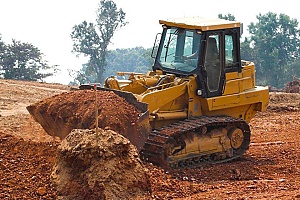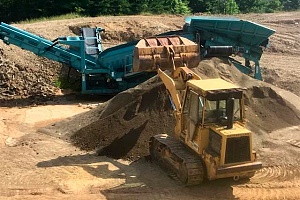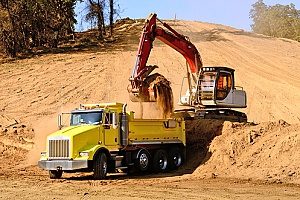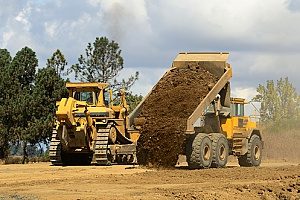Step-by-Step Site Preparation Guide: Setting the Foundation for a Successful Project
 Setting the foundation for a successful project begins with proper site preparation. Whether you’re planning to build a new home, start a landscaping project, or even construct a commercial building, laying the groundwork for success is essential. Our step-by-step site preparation guide will ensure that you have everything you need to get started on the right foot.
Setting the foundation for a successful project begins with proper site preparation. Whether you’re planning to build a new home, start a landscaping project, or even construct a commercial building, laying the groundwork for success is essential. Our step-by-step site preparation guide will ensure that you have everything you need to get started on the right foot.
In this comprehensive guide, we’ll walk you through each crucial aspect of site preparation, from obtaining permits to clearing the land and addressing any potential issues. With our expert advice and proven strategies, you’ll have the confidence and knowledge to tackle your project with ease.
From conducting a thorough site survey to evaluating soil conditions and drainage, we’ll cover it all. We’ll also discuss the importance of utility location, managing vegetation, and creating a solid plan for your project’s timeline and budget.
Ready to set the stage for your project’s success? Read on to discover our step-by-step site preparation guide and embark on a journey toward a smooth and efficient construction process.
Importance of Site Preparation
Site preparation is often overlooked but plays a vital role in the success of any construction project. Proper site preparation sets the stage for the entire project, ensuring that the foundation is strong, the site is safe, and any potential issues are addressed early on.
One of the key reasons why site preparation is crucial is that it allows you to assess the site’s condition and identify any potential challenges. By conducting a thorough site survey, you can determine the suitability of the land for your project, evaluate the soil composition, assess drainage requirements, and identify any existing structures or utilities that may need to be taken into account.
Additionally, site preparation enables you to obtain the necessary permits and approvals from local authorities. Depending on the nature of your project, you may need permits for excavation, land use, zoning, or environmental impact. By addressing these requirements early on, you can avoid costly delays and potential legal issues.
Lastly, site preparation ensures that your project is safe and compliant with regulations. By taking the time to clear the site of any obstacles, manage vegetation, and establish proper safety measures, you can minimize the risk of accidents and ensure a secure working environment for everyone involved.
Now that we understand the importance of site preparation, let’s dive into the step-by-step process to set the foundation for your project’s success.
Assessing the Site Condition
 Before you begin any construction or excavation work, it’s crucial to assess the condition of the site. This assessment involves conducting a thorough site survey to gather information about the land, soil composition, drainage patterns, and any potential challenges you may encounter.
Before you begin any construction or excavation work, it’s crucial to assess the condition of the site. This assessment involves conducting a thorough site survey to gather information about the land, soil composition, drainage patterns, and any potential challenges you may encounter.
Start by hiring a professional surveyor to accurately measure and map the site. This survey will provide you with detailed information about the property boundaries, existing structures, and topography. It will also help you identify any potential issues such as steep slopes, wetlands, or underground utilities that may impact your project.
Next, evaluate the soil conditions to determine its stability and load-bearing capacity. This step is especially important if you’re planning to build a structure on the site. Conduct soil tests to assess its composition, density, moisture content, and compaction characteristics. This information will help you determine if any soil stabilization or compaction measures are necessary.
Lastly, assess the site’s drainage patterns to ensure proper water management. Evaluate the natural slope of the land and identify any potential low-lying areas that may be prone to flooding or water accumulation. Addressing drainage issues early on will help prevent future problems and ensure the longevity of your project.
By thoroughly assessing the site condition, you’ll have a better understanding of its suitability for your project and can make informed decisions moving forward.
Clearing the Site
 Once you’ve assessed the site condition and obtained the necessary permits, it’s time to clear the land. Clearing the site involves removing any vegetation, trees, rocks, or debris that may hinder construction or pose safety risks.
Once you’ve assessed the site condition and obtained the necessary permits, it’s time to clear the land. Clearing the site involves removing any vegetation, trees, rocks, or debris that may hinder construction or pose safety risks.
Start by marking the boundaries of the construction area to demarcate where the clearing will take place. This ensures that only the necessary areas are cleared, minimizing disturbance to the surrounding environment.
Next, remove any vegetation, including trees, shrubs, and grass. Depending on the size of the trees, you may need to hire a professional tree removal service to safely and efficiently remove them. Be sure to follow local regulations regarding tree removal and replanting, if applicable.
After vegetation removal, clear the site of any rocks, debris, or other obstructions. This step is essential to create a clean and level surface for construction. Dispose of the cleared materials responsibly, following local waste management guidelines.
Clearing the site not only prepares the land for construction but also helps address potential fire hazards and improves safety by eliminating tripping hazards or unstable structures. It’s a crucial step in setting the foundation for a successful project.
Land Clearing and Site Preparation
 Excavation and grading are key steps in site preparation, particularly for projects involving foundation construction or landscaping. Excavation involves removing soil or rock from the site, while grading focuses on shaping and leveling the land to meet the desired specifications.
Excavation and grading are key steps in site preparation, particularly for projects involving foundation construction or landscaping. Excavation involves removing soil or rock from the site, while grading focuses on shaping and leveling the land to meet the desired specifications.
Start by determining the depth and extent of excavation required for your project. This will depend on the nature of your construction, such as the foundation depth for a building or the depth of a pond for a landscaping project. Hire an experienced excavation contractor who can handle the excavation safely and efficiently.
Once the excavation is complete, it’s time to focus on grading the land. Grading involves reshaping the site to achieve the desired slope, contour, and drainage patterns. This step is crucial for maintaining proper water flow and preventing erosion.
Work closely with a grading contractor to ensure that the land is shaped according to your project’s specifications. They will use heavy machinery and specialized grading equipment to achieve the desired results. It’s important to strike a balance between creating an aesthetically pleasing landscape and ensuring proper functionality.
By properly excavating and grading the site, you lay the groundwork for a solid foundation, optimize drainage, and create a leveled surface for construction or landscaping.
Drainage and Erosion Control
Proper drainage and erosion control are essential for the long-term stability and success of any construction project. Without adequate drainage measures, water accumulation can lead to soil erosion, foundation instability, and potential damage to structures.
Start by evaluating the natural drainage patterns of the site. Identify any potential areas of water accumulation or poor drainage. Depending on the site conditions, you may need to install drainage systems, such as French drains, swales, or catch basins, to redirect water away from the construction area.
Consider the slope of the land and ensure that it promotes proper water flow. It’s also important to address any erosion-prone areas by implementing erosion control measures, such as retaining walls, erosion control blankets, or vegetation stabilization.
Work with a professional engineer or landscape architect to design an effective drainage and erosion control plan tailored to your specific site. They will consider factors such as the soil composition, topography, and project requirements to develop a comprehensive solution.
By addressing drainage and erosion control early on, you minimize the risk of water-related issues and ensure the longevity of your project.
Utilities and Infrastructure
 Before you can proceed with construction, it’s crucial to address the utilities and infrastructure requirements of your project. This includes locating and identifying existing utilities, such as water lines, gas lines, or electrical cables, and ensuring that they won’t interfere with your construction plans.
Before you can proceed with construction, it’s crucial to address the utilities and infrastructure requirements of your project. This includes locating and identifying existing utilities, such as water lines, gas lines, or electrical cables, and ensuring that they won’t interfere with your construction plans.
Start by contacting the local utility companies to obtain utility maps or conduct a utility locate service. This will help you identify the location of underground utilities on your site. It’s important to be aware of these utilities to prevent accidental damage during excavation or construction.
If you need to connect your project to existing utilities, work with the respective utility companies to determine the requirements and obtain the necessary permits. This may involve installing new water connections, sewer lines, or electrical conduits.
Additionally, consider the infrastructure requirements of your project. This includes access roads, parking areas, or any other necessary structures. Plan and construct these elements to ensure smooth operations during and after construction.
By addressing utilities and infrastructure needs early on, you can avoid costly delays or conflicts and ensure that your project is connected to the necessary services.
Soil Stabilization and Compaction
Soil stabilization and compaction are crucial steps in site preparation, particularly for projects involving foundation construction or heavy loads. These steps ensure that the soil beneath your project is stable, capable of supporting the intended structures, and resistant to settlement.
Start by evaluating the soil composition and characteristics identified during the site assessment phase. Conduct soil tests to determine its load-bearing capacity, compaction characteristics, and moisture content. This information will help you determine the appropriate soil stabilization and compaction measures to take.
Soil stabilization techniques may include adding additives to improve the soil’s properties, such as lime, cement, or chemical stabilizers. These additives enhance the soil’s strength, reduce swelling or shrinking, and improve its overall stability.
Compaction is the process of mechanically densifying the soil to increase its density and load-bearing capacity. This is typically achieved using heavy machinery, such as compactors or rollers, to apply pressure and remove air voids from the soil.
Work with a geotechnical engineer or soil specialist to develop a soil stabilization and compaction plan tailored to your project’s requirements. They will provide guidance on the appropriate techniques, equipment, and compaction specifications to achieve the desired results.
By properly stabilizing and compacting the soil, you ensure the long-term stability and durability of your project’s foundation.
Site Security and Safety Measures
 Site security and safety should be a top priority during site preparation and throughout the construction process. Implementing proper security measures helps protect your assets, prevent theft or vandalism, and maintain a safe working environment for everyone involved.
Site security and safety should be a top priority during site preparation and throughout the construction process. Implementing proper security measures helps protect your assets, prevent theft or vandalism, and maintain a safe working environment for everyone involved.
Start by securing the site with fencing or barriers to restrict access. This helps prevent unauthorized entry and minimizes the risk of accidents or injuries. Install signage indicating potential hazards or restricted areas to ensure that everyone on-site is aware of the safety protocols.
Consider implementing surveillance systems, such as CCTV cameras, to monitor the site and deter potential criminal activity. This provides an additional layer of security and helps ensure that the project is not compromised.
Establish safety protocols and provide adequate training to all workers on-site. This includes proper use of personal protective equipment (PPE), adherence to safety guidelines, and regular safety inspections. Promote a culture of safety and encourage workers to report any potential hazards or unsafe conditions.
Regularly inspect the site for any potential safety risks, such as exposed wires, uneven surfaces, or unstable structures. Address these issues promptly to maintain a safe working environment.
By prioritizing site security and safety measures, you create a conducive and secure environment for your project’s success.
Next Steps
 Site preparation is the crucial first step in any construction project. By following our step-by-step guide, you now have the knowledge and tools to set the foundation for your project’s success. From assessing the site condition to clearing the land, addressing drainage, utilities, and soil stabilization, and implementing site security measures, each aspect plays a vital role in ensuring a smooth and efficient construction process.
Site preparation is the crucial first step in any construction project. By following our step-by-step guide, you now have the knowledge and tools to set the foundation for your project’s success. From assessing the site condition to clearing the land, addressing drainage, utilities, and soil stabilization, and implementing site security measures, each aspect plays a vital role in ensuring a smooth and efficient construction process.
Remember to consult with professionals, such as surveyors, engineers, or contractors, to ensure that your site preparation is done correctly and in compliance with local regulations. They bring expertise and experience that can help you overcome any challenges and achieve the best results.
Now that you’re equipped with the essential information, it’s time to embark on your site preparation journey. Follow each step diligently, adapt to the specific needs of your project, and lay the groundwork for a successful construction endeavor. Good luck!
Planning for Long-Term Site Stability
Investing time in soil stabilization and proper compaction is crucial for the long-term stability of your project. Stabilizing the soil helps prevent future settlement issues and ensures the foundation remains strong under heavy loads. Proper compaction also reduces air voids, which minimizes the risk of shifting or erosion. By prioritizing these steps, you set the stage for a durable and reliable construction outcome, reducing maintenance costs and potential setbacks.
Overview
Proper site preparation is essential for the success of any construction project. From site assessment and land clearing to drainage and soil stabilization, each step ensures a strong foundation and smooth project execution. By addressing these crucial aspects, you minimize risks, comply with regulations, and create a safe working environment. For expert assistance with your project, contact us at Dirt Connections. Let our experienced team handle your site preparation needs, ensuring a successful start to your construction journey.
Summary

Dirt Connections was started with one goal in mind: providing quality residential and commercial construction services to clients on time and on budget. Reach out for more information on how we can support your next project.
For your convenience our estimates are free and by appointment. Call 703-940-9949 for a free estimate today!



